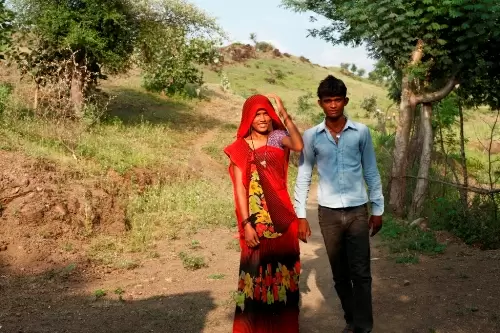“Greater importance must be given to the health needs of women, including their family planning requirements”
01-August-2016
Vol 7 | Issue 31
Ultimately, family planning has to be about a woman’s dignity, privacy and safety, promises that can be fulfilled by mobilising public funds for wider availability of modern contraceptive methods – including intra-uterine device, condoms, male non-scalpel vasectomy, injectables, pills, and so on – and assuring reproductive rights. As the PFI study specifies, to deliver on these, three aspects need to be factored in: firstly, understanding the role of private sector in family planning; secondly, providing quality assurance mechanisms at the ground level; and thirdly, creating avenues for community involvement in generating demand.
Bindiya Devi lives in Okri, a small hamlet in southern Bihar’s Jehanabad district. Like most of her counterparts in the area, she is industrious and adept at multi-tasking – a typical day starts off with a race to finish the household chores after which she rushes off to the fields where she works as a small-time agricultural worker.
 |
|
The absence of information on family planning increases the vulnerability of young couples to untimely pregnancies and even sexually transmitted diseases (Photo: WFS - this image is for representational purposes only)
|
Bindiya’s life isn’t ideal but then her mother too had gone through this grind because it’s the demand of providing for a large family. In fact, this is the lived reality of several families in Bihar, a state where, on an average, a woman has around four children whether or not her health or financial position allows it.
Ask Bindiya why, in times when making ends meet is becoming tougher than ever, does she not limit the size of their family, and she replies with a question of her own: “Do we have another option?”
She goes on to describe the prevailing situation when it comes to accessing contraceptives, “Whereas doctors visiting the health centre emphasise spacing, the choices are limited. Apart from taking birth-control pills that I have to procure, sterilisation seems to be the next best option. In cities various methods are available to women but availability and affordability are major concerns in the rural areas.”
Bindiya belongs to a generation of rural women that is aware of the merits of planning their family but then, as she astutely points out, it’s not enough to know. What is even more essential is to have the freedom to choose the method they feel would be most suitable to their needs and be able to gain access to it. And this is not true just for the women in Bihar or Uttar Pradesh (UP), which are priority states because of their high Total Fertility Rates (in UP its 3.4), but in the rest of the country as well.
As such India’s family planning agenda has traversed a long trajectory to arrive at a broad-based strategy that transcends the simple goal of controlling population growth to one of ensuring better maternal and child health outcomes, reducing morbidity and mortality among mothers and young children, and promoting a choice-based approach to contraception.
It was the National Population Policy of 2000, reflecting the spirit of the 1994 International Conference on Population and Development (ICPD) in Cairo, which first acknowledged the centrality of quality of care and gender equity as part of the overall reproductive health agenda. Later, at the 2012 London Summit of Family Planning, India, along with 60 other countries, pledged to increase women’s access to family planning (FP) services by 2020. As part of the FP2020 commitments, a gradual outlay of over two billion dollars has been earmarked to provide services to an additional 48 million women in the country.
More recently, the mandate for securing women’s reproductive rights has been further consolidated by the Sustainable Development Goals (SDGs). Family planning plays an important role in achieving multiple targets: Goal Three concerning ‘good health’ and Goal Five related to ‘gender equality’ call for reduced maternal mortality, reduced premature, neo-natal and child deaths and universal access to sexual and reproductive health care and rights, including family planning information and education.
The need of the hour has been established: India needs to move on from a strategy that willy-nilly depends on female sterilisation to control the family size and consciously work towards scaling-up investment and service delivery across all states and especially in 246 districts that have significantly poor public health indicators.
However, here’s a reality check: a new study by the Population Foundation of India (PFI) that focuses on projections about India meeting the FP2020 commitments cautions that at the current rate of increase of modern contraceptive prevalence, the country will have about 32.8 million additional users by 2020, i.e., about 15 million short of the committed goal.
Although greater focus on strengthening the health system's capacity to reach the unreached and improve service quality are central to filling this gap, efforts to do so have, so far, been uneven. Despite the fact that the role of social franchise or private players has been highlighted previously, indicating the private sector as a major source of contraception and the government as a major provider of sterilisation services, as per the PFI study there is no scientific evidence to support the premise that the private providers would be able to generate additional users on their own resources.
To better the outcomes it suggests encouraging public-private partnership models along with much higher health allocations by the government. The required resources in this case have been worked out to Rs 276 billion. More specifically, it makes the point that the resources need to be tightly ring-fenced with maximum central share to assure the fulfilment of the commitments. Consequently, besides increasing allocation to states through the National Rural Health Mission on a sustained basis additional money has to be made available to states like Bihar and UP that are in the red.
As such grassroots women do feel the paucity of contraceptive choices. If Bindiya talks about the lack of availability of methods, Kusiya Devi, from Saharanpur in UP, expresses her disappointment on the fact that family planning continues to solely be a woman’s responsibility. She says, “Advertisements talk about condom use but it is very difficult for women to demand it of our men.”
Then there are those who are beginning to voice their frustration at sterilisation still being the most readily proffered option. Rajni another resident of Saharanpur, talks about her bitter experience, “I went in for sterilisation because I felt it would the easier thing to do. However, I fell sick after the procedure and had to be taken to the city for treatment.” Sujata Devi, a panchayat member from a village in Jharkhand’s Gumla district, feels, “Greater importance must be given to the health needs of women, including their family planning requirements. Women need to have a say because it directly concerns our bodies.”
Even in urban areas, where the presence of the private sector is visible in service delivery, women point to the absence of awareness and advocacy on reproductive health. Anisha Sharma, 35, an education professional in Delhi, says pointedly, “Family planning is seen as a woman’s secret job. She has to ensure it by hook or by crook. And yet when it comes to information or counselling regarding picking a suitable method there is really nothing readily available. Often it is only by suffering through adverse consequences that one comes to know what to use and what to avoid. A basket of contraceptive choices as well as awareness about their quality and effects is essential. That’s where the government must step up allocation of resources.”
Ultimately, family planning has to be about a woman’s dignity, privacy and safety, promises that can be fulfilled by mobilising public funds for wider availability of modern contraceptive methods – including intra-uterine device, condoms, male non-scalpel vasectomy, injectables, pills, and so on – and assuring reproductive rights. As the PFI study specifies, to deliver on these, three aspects need to be factored in: firstly, understanding the role of private sector in family planning; secondly, providing quality assurance mechanisms at the ground level; and thirdly, creating avenues for community involvement in generating demand.
It comes down to this: yes, there is a greater need to spend on FP services, but it’s also about spending it the right way. As Tulsi Devi, a panchayat member from UP’s Sitapur district, summarises, “We want safe products, information on them and we want our men to participate as equal partners. Women must be involved at the planning stage of FP programmes; after all, how will our needs be taken care of if we don’t get to vocalise them?”
(Names of the women quoted have been changed to protect their identity.) - Women's Feature Service















